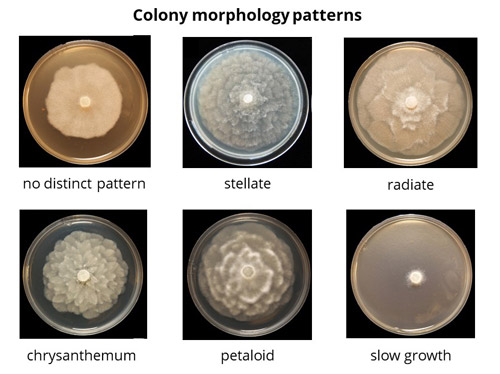Morphology
Morphological protocols
In order to facilitate accurate identification of Phytophthora species, we provide standards of procedures (SOPs) for isolation, maintenance, storage of isolates, methods for sporulation, and other tasks related to morphological identification. Each SOP is available as a downloadable PDF.
SOP-PID-06.01 Morphology: methods for isolation, maintenance, sporulation, and storage
SOP-PID-07.01 Morphology: quick reference guide for isolation and methods for production of asexual and sexual phases
Identification
Morphological identfication of Phytophthora species is based a number of characters of the asexual and sexual phases as well as colony morphology. To see how these stages fit in to the Phytophthora life cycle, please visit the What is Phytophthora? page.
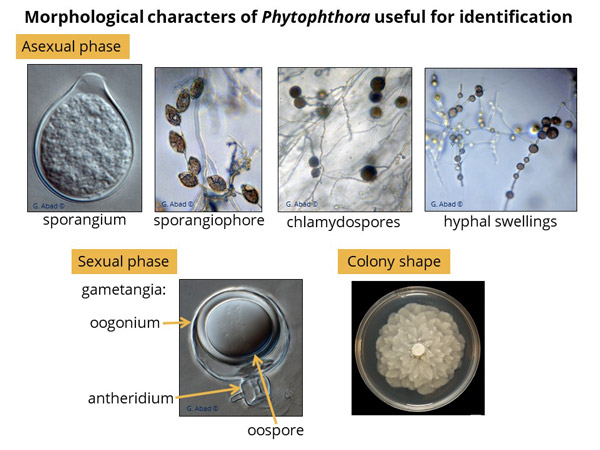
Asexual phase
Sporangia papillation and caducity are important characters for identification, as are the sporangiophoresporangiophore:
the hyphal strand on which the sporangium is formed; may be branched or unbranched to form compound sympodia or simple sympodia
shape, and the presence/absence and shape of hyphal swellings and chlamydosporeschlamydospore:
an asexual spore with a thickened inner wall that is delimited from the mycelium by a septum; may be terminal or intercalary, and survives for long periods in soil
.
Sporangia papillation and caducity
There may be a thickening at the apex of the sporangiumsporangium:
sac within which zoospores form, especially when water is cooled to about 10°C below ambient temperature; in solid substrates, sporangia usually germinate by germ tubes
. In caducouscaducous:
pertaining to sporangia that become dislodged readily (i.e. deciduous) and separate from the sporangiophore (cf. persistent)
species, the sprorangia break off readily. In noncaducousnoncaducous:
pertaining to sporangia that are not dislodged or separated (e.g. persistent) from the sporangiophore (cf. caducous)
species, the sporangiasporangium:
sac within which zoospores form, especially when water is cooled to about 10°C below ambient temperature; in solid substrates, sporangia usually germinate by germ tubes
are retained on the sporangiosphore at maturity. The length of the pedicelpedicel:
the hyphal base of a sporangium that remains attached after the sporangium separates, or is shed, from the sporangiophore; the pedicel may be short (< 5 µm), medium (5–20 µm), or long (> 20 µm)
remaining on caducouscaducous:
pertaining to sporangia that become dislodged readily (i.e. deciduous) and separate from the sporangiophore (cf. persistent)
sporangia may also be helpful for identification.
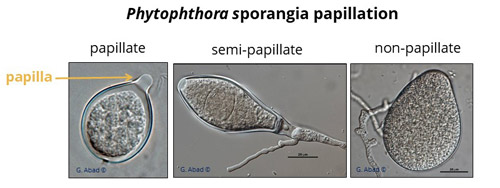

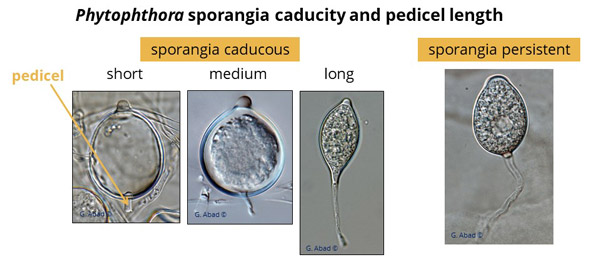
Sporangia proliferation
Sporangia may exhibit internal proliferationinternal proliferation:
internal proliferation occurs when the sporangiophore continues to grow through an empty sporangium
or external proliferationexternal proliferation:
formation of a sporangium after a sporangiophore has emerged from beneath and external to an empty sporangium that has previously emitted its zoospores (cf. internal proliferation)
. External proliferationexternal proliferation:
formation of a sporangium after a sporangiophore has emerged from beneath and external to an empty sporangium that has previously emitted its zoospores (cf. internal proliferation)
can be extended or nested, or both.
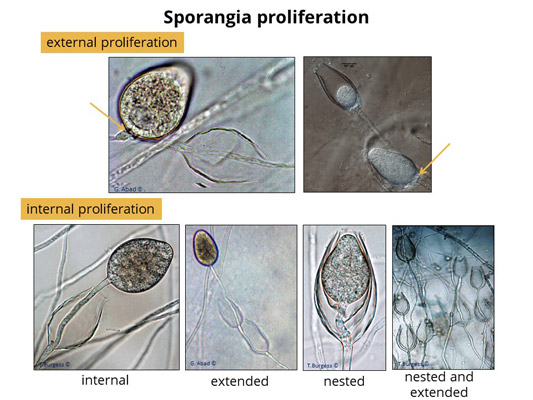
Sporangiophore shape
The sporangiophoresporangiophore:
the hyphal strand on which the sporangium is formed; may be branched or unbranched to form compound sympodia or simple sympodia
can be unbranched (simple) or branched. Branched sporangiophores may be umbellate, simple sympodial, or compound sympodial. One species, Phytophthora litchii, has a specialized type of compound sympodial sporangiophoresporangiophore:
the hyphal strand on which the sporangium is formed; may be branched or unbranched to form compound sympodia or simple sympodia
that appears erected, very similar to those of downy mildews.
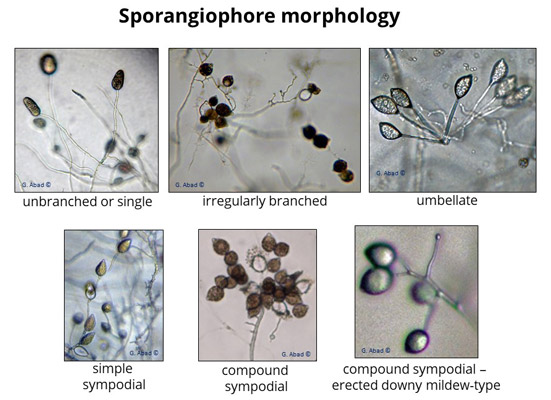
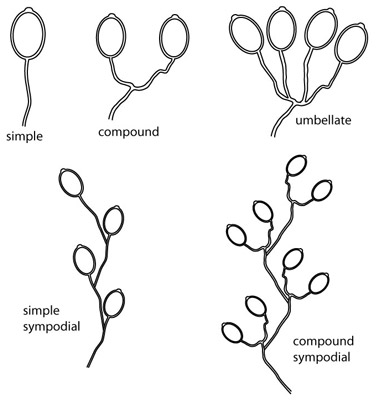
Chlamydospores and hyphal swellings
Chlamydospores and hyphal swellings may be present or absent. When present, they can be intercalaryintercalary:
positioned within a hypha (cf. terminal)
(in the middle of a hyphahypha:
single, tubular filament of a fungal or oomycete thallus; the basic structural unit of a fungus or oomycete
) or terminal (at the end of a hyphahypha:
single, tubular filament of a fungal or oomycete thallus; the basic structural unit of a fungus or oomycete
), and can vary in shape and distribution.
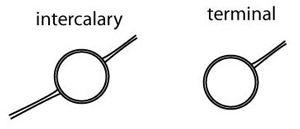
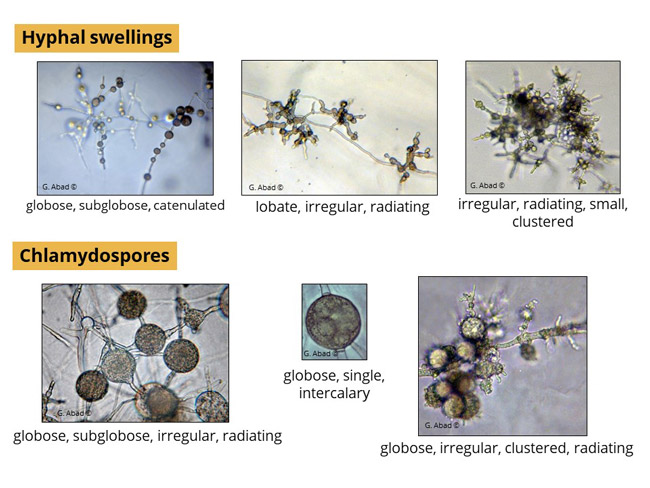
Sporangia shape
Sporangia vary widely in shape, but this character is not very helpful for identification.
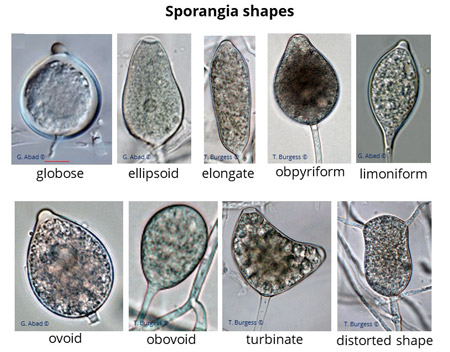
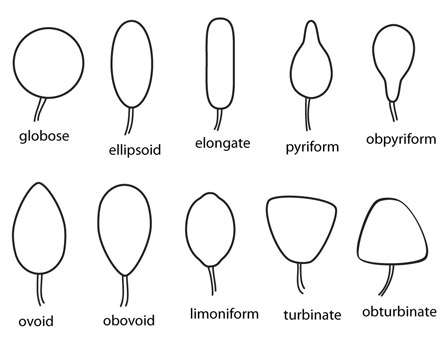
Sexual phase
Aspects of the sexual phase that are helpful for identification include whether the species is homothallichomothallic:
pertaining to sexual reproduction that can take place within a single thallus (i.e. self-fertile, non-outcrossing) (cf. heterothallic).
or heterothallicheterothallic:
pertaining to sexual reproduction in which conjugation is possible only through interaction of different thalli (i.e. different mating types) (cf. homothallic)
, the shape of the gametangiagametangium:
part of hypha specialized for fusion in sexual reproduction (see antheridium and oogonium)
(antheridia and oogoniaoogonium:
the female gametangium in which the oospore forms after fertilization by the antheridium
), and the shape of the oosporeoospore:
zygote or thick-walled spore that forms within the oogonium after fertilization by the antheridium; may be long-lived
.
Antheridium
The antheridiumantheridium:
the male gametangium; a multinucleate, swollen hyphal tip affixed firmly to the wall of the female gametangium (the oogonium)
may be paragynousparagynous:
pertaining to the sexual stage in which the antheridium is attached to the side of the oogonium (cf. amphigynous)
(next to the oogonial stalk) or amphigynousamphigynous:
pertaining to the sexual stage in which the antheridium completely surrounds the stalk of the oogonium (cf. paragynous)
(around the oogonial stalk).
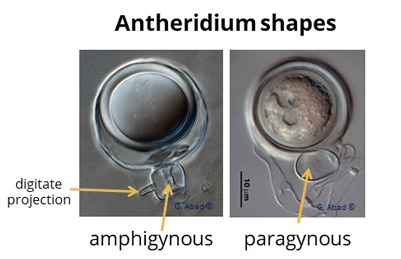
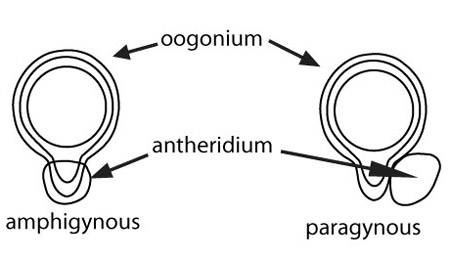
Oogonium
The oogoniumoogonium:
the female gametangium in which the oospore forms after fertilization by the antheridium
may be smooth or ornamented and may have a tapered basetapered base:
pertaining to the base of a sporangium or oogonium; funnel-shaped
.

Homothallism vs. heterothallism
Homothallic homothallic:
pertaining to sexual reproduction that can take place within a single thallus (i.e. self-fertile, non-outcrossing) (cf. heterothallic).
species are self-fertile and non-outcrossing, with both sexual mating types in a single culture. Heterothallicheterothallic:
pertaining to sexual reproduction in which conjugation is possible only through interaction of different thalli (i.e. different mating types) (cf. homothallic)
species have separate mating strains or types, so they are sterile without the interaction of different thalli of opposite mating types.
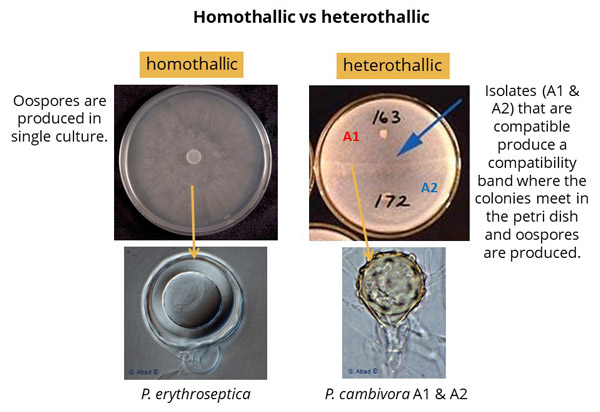
Oospore
May be pleroticplerotic:
pertaining to an oospore that fills the oogonium (cf. aplerotic)
(no space between oosporeoospore:
zygote or thick-walled spore that forms within the oogonium after fertilization by the antheridium; may be long-lived
wall and oogoniumoogonium:
the female gametangium in which the oospore forms after fertilization by the antheridium
wall; the oosporeoospore:
zygote or thick-walled spore that forms within the oogonium after fertilization by the antheridium; may be long-lived
fills the entire oogoniumoogonium:
the female gametangium in which the oospore forms after fertilization by the antheridium
) or apleroticaplerotic:
pertaining to a mature oospore that does not fill the oogonium; i.e. there is room left between the oospore wall and oogonium wall (cf. plerotic)
(with space between the
oospore oospore:
zygote or thick-walled spore that forms within the oogonium after fertilization by the antheridium; may be long-lived
and oogoniumoogonium:
the female gametangium in which the oospore forms after fertilization by the antheridium
walls), or slightly apleroticaplerotic:
pertaining to a mature oospore that does not fill the oogonium; i.e. there is room left between the oospore wall and oogonium wall (cf. plerotic)
.
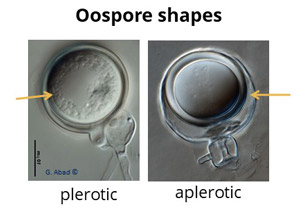
Colony colony:
assemblage of hyphae which usually develops form a single source and grows in a coordinated way
morphology
The shape of the colonies produced on particular media may also be helpful for species identification.
